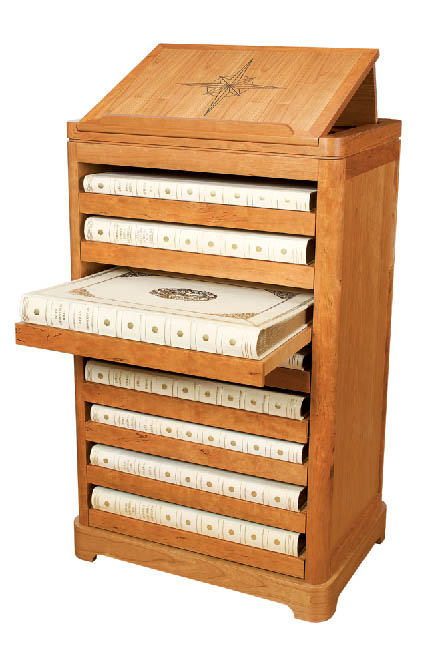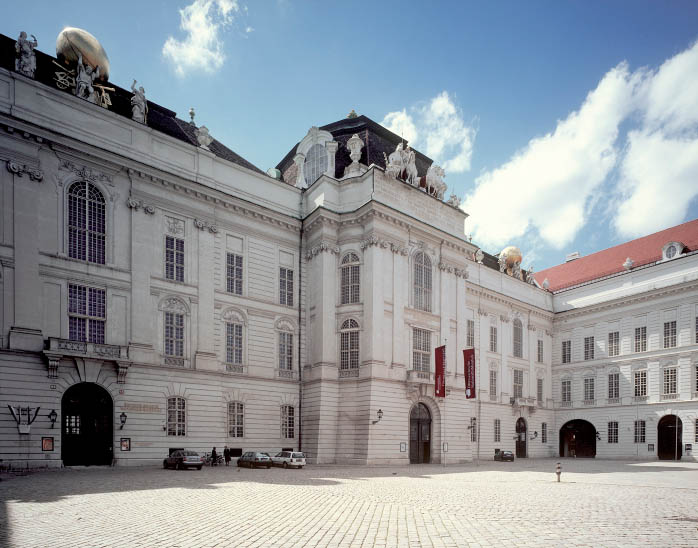 Introduction
page to the Atlas Blaeu - Van der Hem
Introduction
page to the Atlas Blaeu - Van der Hem Introduction
page to the Atlas Blaeu - Van der Hem
Introduction
page to the Atlas Blaeu - Van der Hem
Notes taken during the Symposium “Atlas Van der Hem”
Amsterdam, April 16, 2009 on the Atlas Blaeu – Van der Hem in the the
Austrian National Library in Vienna on Hofburg square.
(image 1, Österreichische Nationalbibliothek, Wien).
Images listed below include 4 images provided by the publisher.
Kees Kaldenbach
One night back in 1992 one of the most important large atlases in the world, the Atlas Maior by Blaeu
was nearly destroyed by a huge fire burning in the attic of the Austrian National
Library in Vienna on Hofburg square.
(image below, Österreichische Nationalbibliothek, Wien)
People who worked there - and knew where the Atlas Blaeu – Van der Hem
was kept right there up in the attic – stared upwards in horror and felt
that all treasure was lost. Only a full set of black and white photographs would
remain as a relic of this famous Atlas. However, the Goddess of Fate decided otherwise. The Atlas was unharmed.
During the next year the atlas, which miraculously escaped, was successfully
submitted and entered on the UNESCO world heritage list - and has since gained
worldwide fame. (Note 1)
The Atlas van der Hem is named after its seventeenth century owner,
the Amsterdam lawyer Laurens van der Hem (1621-1678) who lived, worked and thrived
in what was then the centre of world trade and mapmaking. Van der Hem was an independently wealthy
Roman Catholic man who had studied law in Leuven / Louvain (now Belgium), then
in Roman Catholic Flanders. After finishing a Grand Tour in the Roman Catholic
countries France and Italy, he returned to Amsterdam where he may have preferred
to be in Roman Catholic circles and he consorted with the Jesuits to whom he
donated a canal house on Herengracht 14. He was an old fashioned supporter of divine
order, worldly hierarchy and especially Roman Catholic monarchy and from the
titles in his library we can see that he eschewed new fangled ideas in philosophy
and natural sciences.
Wealthy he certainly was – and it helped that in 1650 he married Maritga
Schagen, a Roman Catholic woman, and they proceeded to live together in a grand
mansion inherited from her father, on Herengracht 115. In 1674 he was taxed
for owning a property of 200.000 guiders, bringing him in the league of the
100 richest inhabitants of Amsterdam (note 2).
And money he needed indeed - in great amounts for his expensive passion. After settling
in Amsterdam after finishing his Grand Tour he bought the Atlas Maior by Joan Blaeu, the largest and most luxurious
atlas for sale in the entire world. Basically it was intended by the publisher as a gift for ambassadors and kings. The Atlas Maior cost van der Hem about 330 guilders, then equal
to a full year’s income for a skilled workman. He purchased the Atlas
Maior from the Famous Joan Blaeu firm of mapmakers. The atlas he bought may
well have consisted of loose, non-coloured black and white printed sheets (thus
not bound in the standard 11 volume folio size book binding). He then took the
600 atlas images of the Blaeu atlas as a just a starting point of his own project
and added to Blaeu more than 2100 extra printed maps, bringing his atlas map
project to a stunning sum total to 2705 maps and thus making it one of the largest
atlases in the entire world. Thus Van der Hem became the perfect armchair traveller.
Added prints and drawings
Laurens van der Hem added illustrations. Extra drawing sheets, which he bought in subsequent
sales by the dozens were also included - and if an original drawing turned out
to be smaller than the folio size of the Blaeu format they were enlarged by
gluing extra paper all around the edges and sometimes the image was added on
to to extend to full page size. To the atlas maps he added some 4200 image prints
and about 20.000 drawings, a number of them made especially to order by good
draughtsmen such as Willem Schellinks.
Thus working on this project - perhaps on a daily basis became his lifetime
achievement. In order to finish the job he hired a number of draughtsmen to
make extra series of copied drawings, in full folio size, of places and other
images throughout in the world, of topographical views of towns and ultra wide
landscapes. The most stunning landscapes are fold-out sheets stretching up to
4 meters wide.
Map heaven
Seventeenth century Amsterdam was the best place to collect these maps, charts
and drawings as captains working for the VOC and WIC landed there and handed
their logbook information in the form of text and drawings to their employers,
the VOC. VOC, or the United East India Company, was founded 1602 had the trading
monopoly in the east towards what is now Indonesia, and WIC founded a little
later traded westwards with the Americas. The Atlas Van der Hem also includes
a print section of ultra secret VOC and WIC information sheets, intended for
their internal use only. Obviously Van der Hem was also in very close contact
with Joan Blaeu of the Atlas firm but also with art auctioneers and other enthusiasts
and collectors of topographic material.
The next step was to hire the best colouring artists (a trade group named “afzetters”,
colourists) in Amsterdam, including the peerless Dirk Jansz van Santen,
for a period of four years and instructed them to create an unsurpassed works
of illuminated graphic art. Not only did they use the finest mineral pigments
available worldwide to great effect - but also the very best gold powder, consisting
of pure high grade crushed gold leaf, labelled “schulpgoud”.
Visits by VIPs
Van der Hem was a proud Atlas owner and wanted to share his enthusiasm and expertise
by inviting important guests into his home to admire his collection. As we have
no diary or letters describing his project, it is not known whether the whole
project was already in a bound form or just a loose-leaf system. We know of
some snippets of information, shedding light on the fame he enjoyed. One of
the high-ranking visitors was Cosimo de Medici who was about 20 years old when
he visited the Atlas Van der Hem on January 2, 1668. According to the author
Daniel Papenbroek, the young Cosimo de Medici offered a good sum of money for
the Atlas – in the unbound or collated state as it was shown to him then.
The kind offer was denied by van der Hem. Another traveller, the French
medical doctor Charles Patin listed the four most important private collections
to be visited in Amsterdam in 1671, being those of Mr. Witsen, Mr. Lucas Occo
of Assendelft, Mr. Van der Hem and Mr. Grill.
Enthusiam and expertise were not everything. There is a quote of Van der Hem
himself, stating that he was doing the project because it as “a honorable
pastime” (Dutch: "een eervolle ontspanning").
 Auctions
Auctions
At the time of his death there were 32 folio books in existence. His children
combined the rest of the material in a sum total of 46 folio books and since
then 4 supplements have been added of stray material that has later been identified
as Van der Hem Atlas items. Thus the grand total is now 50 folio books. The
material was auctioned off in 1684 by his children. Then the next auction of
this atlas was in 1730, when the Austrian-Habsburg military leader Prince Eugene
of Savoy purchased the set and the next owner was the Emperor of Austria who
was aware that he owned a magnificent atlas and showed it to visitors as a key
property. Subsequently the fame of the atlas was slowly forgotten, also in academic
circles. In the 1960s interest was slowly rekindled.
Having miraculously survived the fire, Austrian National Library in Vienna on
Hofburg square has well kept the folio books - they still look pristine, every
sheet fresh and crisp as if it was created yesterday. The gold leaf stunning,
an element that catches your breath and is a feast to the eye.
High Fidelity Reproduction
Presently the set of folio books are being reproduced, volume by volume, with
the highest fidelity by Hes & De Graaf Publishers. For the gold leaf the
printing team uses the same crushed gold leaf, and the sheets are printed with
glue patterns to catch those gilt areas. The effect surpasses regular gold leaf
transfer printing. This fine effect does however NOT show up on these great
high-resolution Internet reproductions.
For more Atlas Van der Hem - Blaeu images click on the pages below. Images listed below are 4 images provided by the Publisher for promotional purposes (© ONB).
Start here: Main Atlas project page
Back to Deshima, Japan map
Back to Goa, India map
Back to New York State, Connecticut etc. New Amsterdam map
Back to Drawing of sailors hammock on a ship
NEW. For the first time on Internet: The Huber Birds eye view, 1777, of Vienna / Wien kept in the same building.

Literature:
Atlas van der Hem Catalogue Raisonné ;
http://cartography.geog.uu.nl/research/vanderhem.html
Innocence Abroad: The Dutch Imagination and the New World, 1570-1670 by Benjamin
Schmidt. Cambridge: Cambridge University Press, 2001. 450 pp.
http://mlq.dukejournals.org/cgi/pdf_extract/64/3/389
Publisher of the Atlas van der Hem luxury reprint:
http://www.blaeuvanderhem.com
Note 1, see Unesco page
Note 2, map of Amsterdam with dots.
http://www.xs4all.nl/~kalden/auth/zandvliet250rijksten.html
The author Drs Kees Kaldenbach has an active interest in Vermeer. Vermeer painted many wall maps in his paintings. See his 2000+ page web site on Vermeer and Delft at /http://www.xs4all.nl/~kalden/
Contact information: Private Art Tours, Amsterdam.
http://www.xs4all.nl/~kalden/verm/tourmenuENG.html
Drs. Kees Kaldenbach , kalden@xs4all.nl
Haarlemmermeerstraat 83 hs
1058 JS Amsterdam
The Netherlands
telephone 020 - 669 8119
(from abroad NL +20 - 669 8119)
cell phone 06 - 2868 9775
(from abroad NL +6 - 2868 9775)
How to get there (after your booking confirmation!):
- by car: ring road exit S 106 towards the centre, then 1st to the right (paid parking)
- by trams 1 and 17; exit at Surinameplein
- by tram 2; exit Hoofddorpplein.
======== Book reviews ============
Adriaen Coorte, by Quentin Buvelot, book & exhibition catalogue.
De Grote Rembrandt, door Gary Schwartz, boek.
Geschiedenis van Alkmaar, boek.
Carel Fabritius, Tentoonstellingscatalogus.
Frans van Mieris, Tentoonstellingscatalogus.
From Rembrandt to Vermeer, Grove Art catalogue, book.
Vermeer Studies, Congresbundel.
C. Willemijn Fock: Het Nederlandse interieur in beeld, boek.
Het Huwelijksgeschenk (1934), boek over de egoïstische vrouw, die haar luiheid botviert.
Zandvliet, 250 De Rijksten van de Gouden Eeuw , boek + nieuwe stippenplattegrond!
Ik doe wat ik doe, teksten van Lennaert Nijgh , boek + cd
Het Rotterdam Boek, boek.
Bouwen in Nederland 600 - 2000, boek.
Hollandse Stadsgezichten/ Dutch Cityscape, exhib. cat.
Zee van Land / over Hollandse Polders (NL) boek
Sea of Land / about Dutch Polders (English) bookTEFAF 2008 art fair
Updated June 9, 2016.r
====================